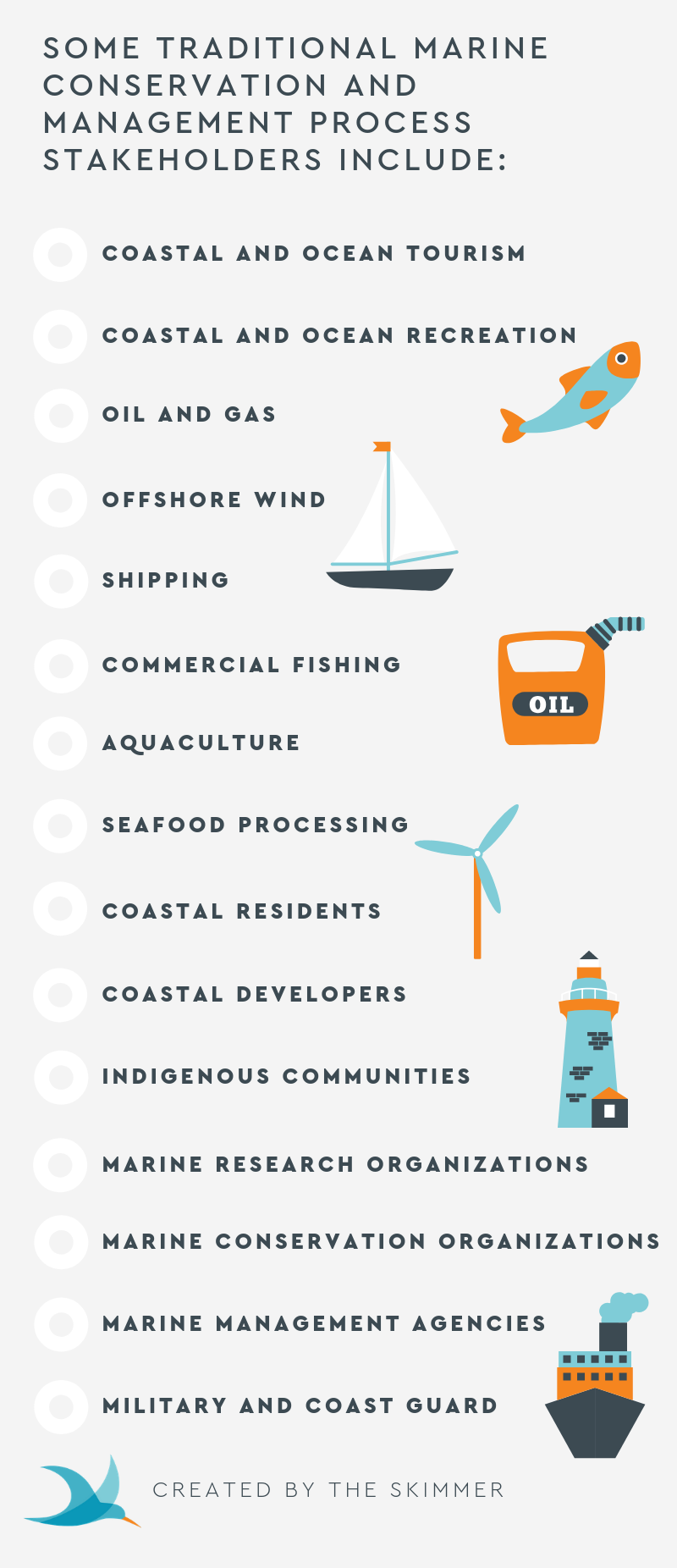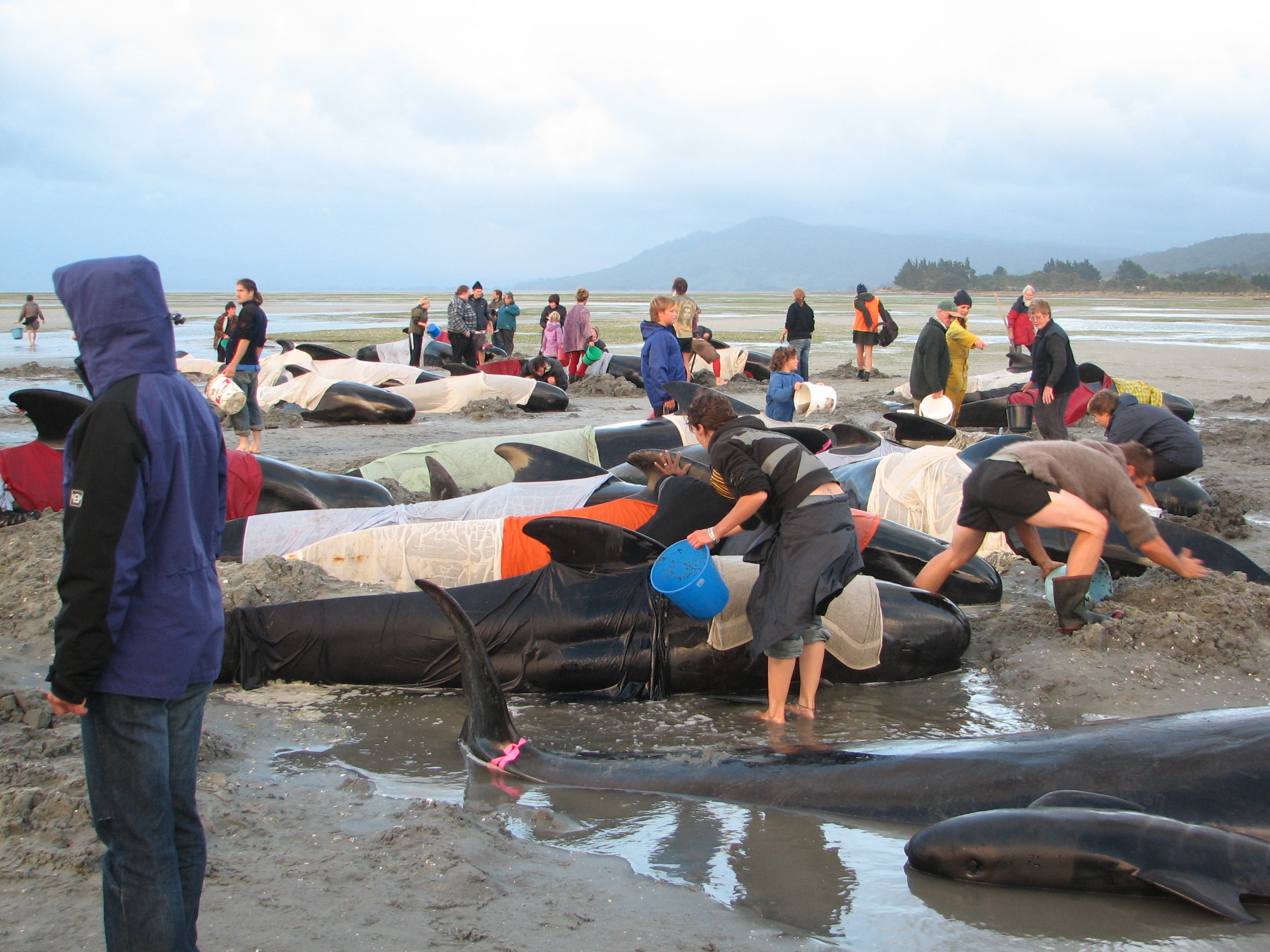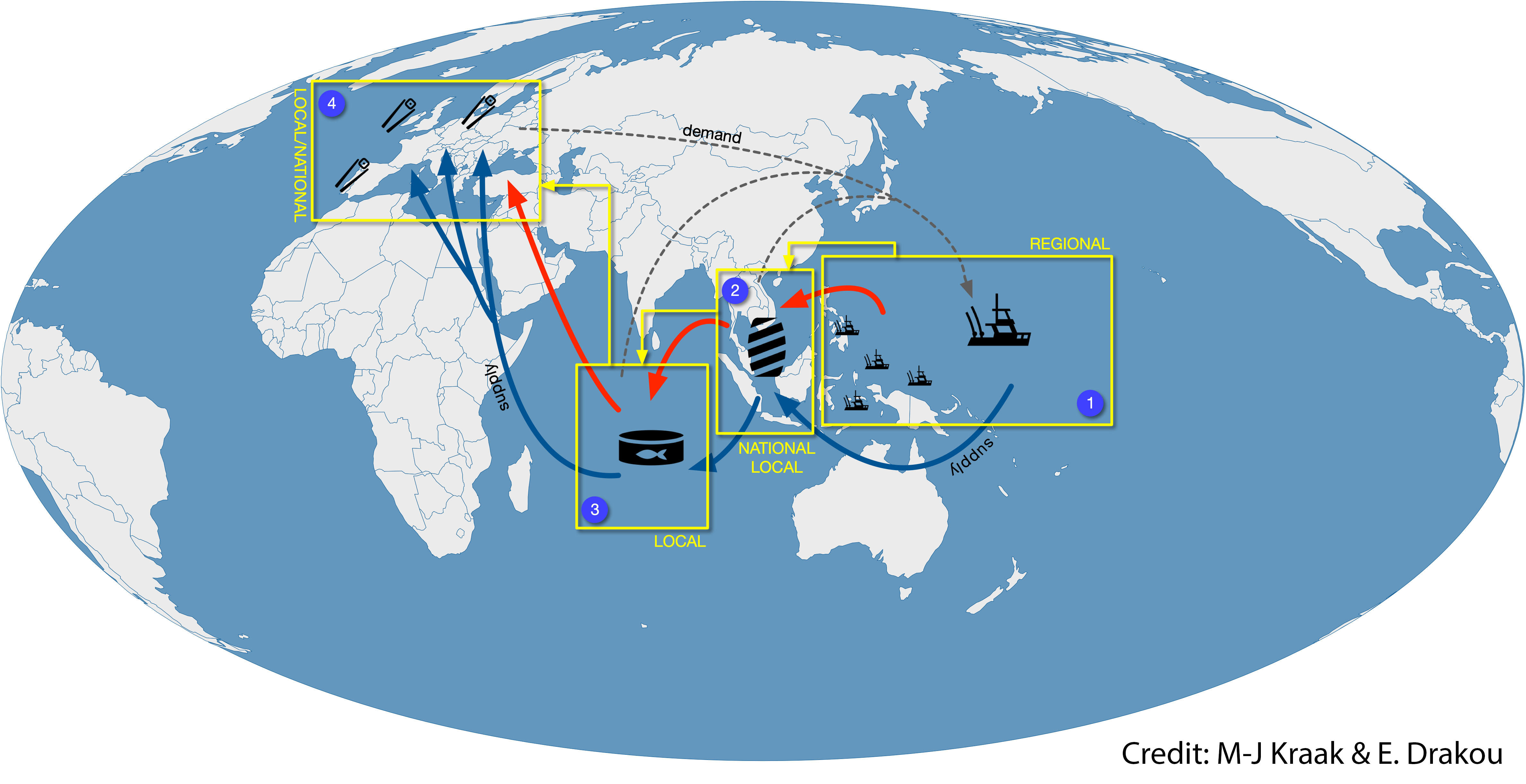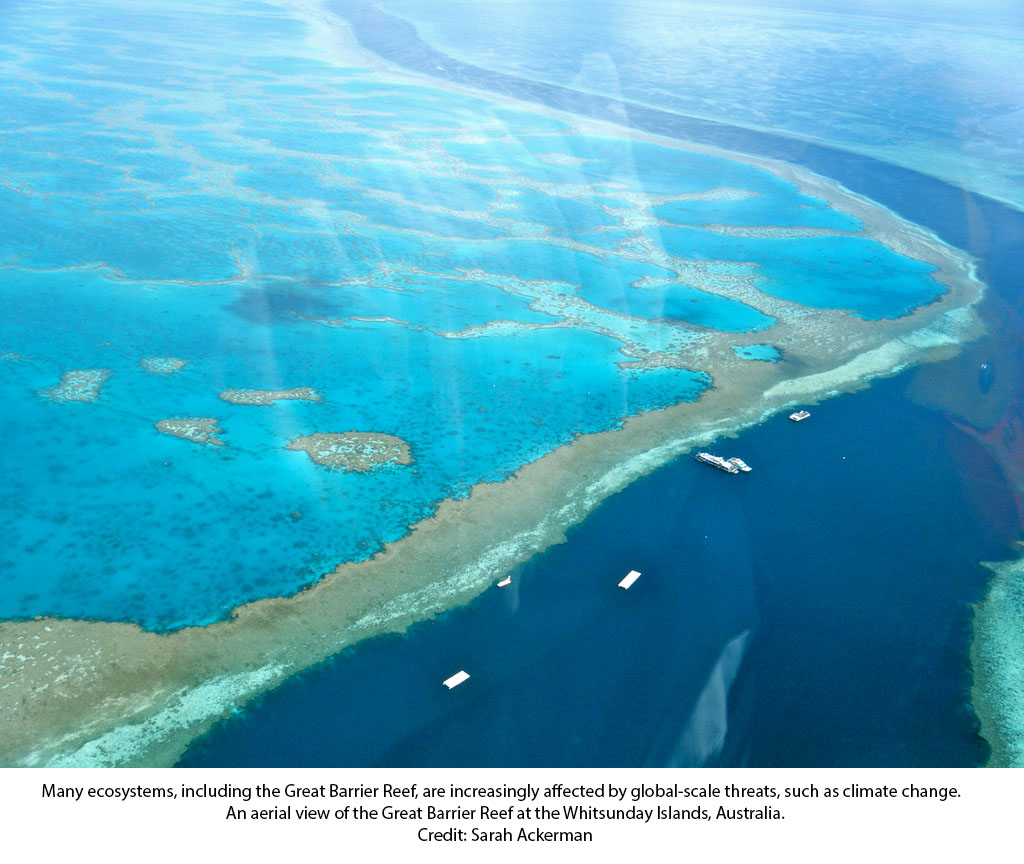In recent years, stakeholder engagement has been widely recognized as integral to effective marine conservation, marine ecosystem-based management, and  marine spatial planning. There are many different definitions of the term ”stakeholder”, but at its most inclusive, it is any “person, organization, or group with an interest (professional or societal) or an influence on the marine environment or who is influenced directly or indirectly by activities and management decisions.” The list of stakeholders engaged in any marine conservation or management process depends on the context of the specific project, but, in practice, typical stakeholders engaged in marine conservation and management processes include local industries, coastal residents, management agencies, and conservation organizations.
marine spatial planning. There are many different definitions of the term ”stakeholder”, but at its most inclusive, it is any “person, organization, or group with an interest (professional or societal) or an influence on the marine environment or who is influenced directly or indirectly by activities and management decisions.” The list of stakeholders engaged in any marine conservation or management process depends on the context of the specific project, but, in practice, typical stakeholders engaged in marine conservation and management processes include local industries, coastal residents, management agencies, and conservation organizations.
The world is changing rapidly though. New information and technologies, new forms of social interaction (often fostered by social media), increases in tourism around the globe, shifting economies, globalization, global climate change, and other factors make it critical to continually reexamine traditional views of who ocean stakeholders are, their relative importance, and how we engage them.
In this issue of The Skimmer, we feature three recent studies that highlight new (or often underrepresented) voices in ocean management processes, as well as thoughts on how these voices can be brought into decision making for marine ecosystems.
- One of these studies found the value of marine stewardship activities is greater than the revenues from commercial finfish and whale watching activities in the US state of Massachusetts.
- Another study presents the concept of “extra-local ecosystem services” – ecosystem services provided by coastal and marine ecosystems that are distributed beyond the ecosystem itself, including regionally and globally.
- A third study – of place attachment to the Great Barrier Reef – found a community of people with strong attachment to the reef who do not necessarily have ongoing direct experience with it.
Add to this article! Do you know of other research that provides new perspectives on ocean stakeholders? Share with other readers in the Comments below.
Joe Roman: Environmental groups are not just advocates – they’re essential players in the coastal economy
Editor’s note: Joe Roman is a Fulbright–NSF Arctic Research Scholar at the University of Iceland and a conservation biologist at the Gund Institute for Environment at the University of Vermont in the United States. This interview discusses the paper “Stranded capital: environmental stewardship is part of the economy, too” published in Frontiers in Ecology and the Environment in 2018.
The Skimmer: For this study, you and your co-authors quantified the contribution of marine-related environmental stewardship – in the form of donations and volunteer hours – to the economy of coastal Massachusetts in the United States. What did you find?
Roman: A few years ago, I was teaching a class on Cape Cod when my students and I came upon a stranding of four dolphins in Wellfleet, Massachusetts. Eight employees of the International Fund for Animal Welfare soon arrived, as did 16 volunteers. Two police officers and a crowd of 35 bystanders were also present at the scene as the dolphins were released back into the ocean. Since we had been interviewing different stakeholders for the class, including commercial fishermen, oyster farmers, and people involved in developing wind farms, it occurred to me that we were overlooking an important part of the economy: marine stewardship. So we decided to look at the budgets of local marine conservation groups.
My colleagues and I found that the total budget of the marine environmental organizations and their attendant volunteer activities in Massachusetts was worth US$122 million per year. This is more than the value of landings of finfish (US$105 million) and revenues from whale-watching (US$111 million) in the state.
The Skimmer: Should these results influence our view of who stakeholders are (or the relative importance of various stakeholders) for coastal and marine resource management processes in coastal Massachusetts? Should people who donate their time and/or money to coastal stewardship in coastal Massachusetts be considered stakeholders alongside those who are dependent on coastal and marine resources for their livelihood or those who have some control/ownership over coastal and marine resources?
Roman: Yes, I think that’s an important point. Economists often try to estimate the value of conservation actions through surveys, with people expressing their willingness to pay for a particular action, such as saving humpback whales. It’s an important technique, but it overlooks the role that environmental groups play in the coastal economy. These organizations provide local jobs, and the money they raise is often spent on goods and services. Marine stewardship is a part of the economy, too. Environmental groups deserve a place at the table in discussions about marine management in Massachusetts: not as advocates against economic development, but as essential players in the coastal economy.
And it’s not just marine stewardship. Over the past several decades, the coastal economy of Massachusetts has been transformed from one dependent on wild-capture fisheries to a diverse economy that includes stewardship, recreational fishing, whale watching, and aquaculture. These sectors can work together to improve our management of the ocean.
The Skimmer: Are there any other ways that the contributions of marine stewards should be accounted for in public processes and decision making?
Roman: Well, it’s really about the outcomes. Let’s take the Conservation Law Foundation, based in Boston, as an example. In 1985, they sued the US Environmental Protection Agency and the Metropolitan District Commission for violating the Clean Water Act (and won) because these entities were allowing 3.5 billion gallons of pollutants to be dumped into Boston Harbor every year. As a consequence of this case, Boston Harbor is now considered to be one of the cleanest in the country. Wildlife has returned to the area, and residents and visitors can once again boat, swim, and fish there. So it’s not just the money, it’s the results that come from these efforts that really matters.
The Skimmer: So how should we think about marine stewardship, e.g., is valuing marine stewardship a new approach for valuing “other” ecosystem goods/services, is marine stewardship an ecosystem good/service in and of itself that needs valuation, or is marine stewardship really its own economic sector?
good/service in and of itself that needs valuation, or is marine stewardship really its own economic sector?
Roman: We’ve thought about this a lot. From one perspective, marine stewardship is an example of a cultural ecosystem service, a “relational value,” which is discussed in a nice paper published by Chan et al. in 2016 entitled Why protect nature? Rethinking values and the environment. The benefits of stewardship are different from the traditional “use” values we get from nature. Returning stranded dolphins to the ocean will not result in any direct economic benefits. Those who donate and work for conservation organizations can be motivated by instrumental values (fishing), intrinsic values (the value of nature independent of people), or a sense of moral and social responsibility.
As we note in the paper, the State of Maryland developed a value-added scorecard to help guide decision making on restoration projects and other conservation expenditures. In analyzing the return on investment of its state parks and other conservation lands, Maryland quantified volunteerism and stewardship as social benefits that are on par with economic benefits such as flood protection and environmental benefits such as biodiversity. We believe that these instances of stranded capital – donations, volunteerism, and other overlooked activities – should be taken into greater consideration and play a more direct role in policy and valuation studies.
As an aside, I should share that I am not a huge fan of the word stakeholder. Here’s what I wrote about this in a recent article in Trends in Ecology and Evolution:
“The word ‘stakeholder’ dates back to the 18th century, when it referred to individuals who held money during financial transactions or bets. During the 19th and 20th centuries, it expanded to include people or companies dedicated to the success of a business or sector. Given the financial roots of the word, it is no wonder that conservationists have eyed the term with suspicion. Can you be a stakeholder for a group of whales or a deep-sea ecosystem? Or do we need a new term?”
Evangelia Drakou: It is no longer enough to manage marine ecosystem services locally
Editor’s note: Evangelia Drakou is assistant professor of Geo-Information Processing at the University of Twente in the Netherlands. This interview discusses the paper “When ecosystems and their services are not co-located: oceans and coasts” published in the ICES Journal of Marine Science in 2017.
The Skimmer: Can you tell us a bit about what extra-local ecosystem services are? Can you provide some examples?
Drakou: In our paper, we use the term “extra-local ecosystem services” for the benefits (or nature’s contributions) that are supplied by an ecosystem (locally) to people located far from this ecosystem (extra-locally). And we make the case that understanding and valuing this type of ecosystem service requires both a dedicated framework and a dedicated methodology that can be applied across ecosystems and services – particularly for marine and coastal systems.
The novelty of this approach lies in two key elements:
- The emphasis on the role of the spatial attributes of the system. Up until now the flow and distribution of nature’s benefits to people that live far away from the area in which the benefit is supplied have primarily been measured in terms of monetary or non-monetary values. There has only been limited mapping of this information, and outputs are relatively static snapshots in space and time. Emphasizing the spatial component of these flows of nature’s benefits to society brings a new perspective, and showing how a local ecosystem can benefit people globally can change the notion of who the stakeholders are and consequently the way this information informs decision making.
- The role of intermediate processes, benefits, and beneficiaries in the ecosystem service supply process. The framework puts extra emphasis on the intermediate benefits and beneficiaries which emerge and focuses on mapping them. In many cases, especially in the marine environment, the role of the intermediaries is so important that it becomes a key driver of the ecosystem service flow. For instance, trans-shipment companies (immediate beneficiaries) operating in the West and Central Pacific Ocean region contribute to the tuna fish trade and flows by transporting tuna from fishing vessels to processing facilities and distribution centers across the world. The amount of tuna managed by these companies reaches millions of tons, and the monetary benefits generated by transshipment is as a driving force in fishery supply chains.
This framework applies in all types of services provided by marine ecosystems. For instance, tuna in the South Pacific Ocean is caught (locally) primarily by foreign purse seine fleets which buy licenses from local governments. Hence benefits from this fishery are generated not only for the local country but also for other countries and regions i.e., extra-locally. The tuna caught is then either processed on board or shipped to other places for processing, and it is then shipped to markets all over the world – highlighting both the extra-locality and the intermediaries in the flow of benefits.
Another example is nature-based tourism. Ecosystems rich in keystone species (e.g., fin whales) often receive tourists from all over the world. In these situations, tourists receive the aesthetic and recreational benefit of encountering a whale locally, and this benefit stays with them even when they go back to their country (extra-locally).
The case of climate regulation through carbon sequestration is also a very good example of extra-local ecosystem services. A patch of coastal mangroves (locally) can capture and sequester carbon, benefitting the well-being of the global population (extra-locally).
The Skimmer: Can you tell us a little bit about the state of the science of understanding and mapping extra-local ecosystem services?
Drakou: Our understanding of these processes is growing daily, and more and more frameworks are emerging for addressing them, although most of these frameworks are for terrestrial rather than marine systems.
What is still lagging behind is the mapping of these extra-local ecosystem services. Most ecosystem service maps are static “snapshot” maps that focus on one point in space and time and do not show the global picture. We need to move beyond that because dynamic maps using recent advances in cartography and geo-information science can provide map users with better scientific information on ecosystem services. This is what our research group is currently working on.
The Skimmer: Since your work shows that people outside of a local ecosystem can benefit or be harmed by changes within a local ecosystem, do you feel that this should expand our idea on who stakeholders for coastal and marine resource management processes are (or alter the relative importance of various stakeholders)?
Drakou: Absolutely. This is the entire raison d’être behind this paper. Up until now we have usually considered stakeholders to be people who benefit from an ecosystem locally. In fisheries, however, 70% of fish landed is consumed by people who live far from the place where the fish is actually harvested, and fisheries value chains sometimes spread across oceans and continents. The sale of sushi in restaurants and supermarkets all over the world is driving fishing pressure in the South Pacific with all its attendant environmental and social impacts, even slavery.
One of the key messages we wanted to pass along with our framework is that everyone plays a role in the flows of marine benefits to society. There are many intermediate and final beneficiaries or stakeholders – from big transnational corporations to individuals – who have power to change the system. And it is time to utilize these beneficiaries/stakeholders. For example, it has been shown that big non-state corporations have the power to influence future harvesting and fish production patterns as well as governance regimes in marine ecosystems. Similarly, the expansion of individual extra-local seafood consumption choices – such as sushi in supermarkets across the world – also drive the state of marine resources at the point of harvest. It is time to acknowledge the role of these beneficiaries/stakeholders in national and regional decision making and governance mechanisms.
The Skimmer: Do you have suggestions for ways that those affected by extra-local ecosystem services can be brought into public processes and decision making for those services?
Drakou: There are three steps for doing this.
- The first step is recognizing those affected by and those affecting extra-local ecosystem services in marine ecosystems. With the extra-local ecosystem services approach, we unravel the ecosystem service supply chain and account for the role of different types of beneficiaries – direct and intermediate – and recognize the added costs and benefits those beneficiaries generate throughout the ecosystem service supply process.
- The next step is incorporating information about these stakeholders in the maps we produce. That allows us to better communicate the role and importance of the different stakeholders involved in the extra-local ecosystem service supply in different locations around the globe. The power of maps to communicate this information is recognized, but we need to improve our mapping so decision makers can understand it more efficiently. Our research team is working on this issue by testing the use of dynamic, interactive maps and their impact on decision makers.
- Finally, it is crucial to involve non decision makers and non-scientists in public processes because the extra-local framework shows that efforts of individuals are critical. We need to expand and improve literacy campaigns and education to help individuals understand how they benefit from the oceans and how they can act more responsibly towards it.
Still it is important to recognize that bringing new scientific information into decision making is usually a long-term process that requires mutual agreement by people with roles in the decision-making process. Existing policies need to be expanded so they go beyond ecosystem-based management and consider the global nature of marine ecosystem services. It is no longer enough to manage marine ecosystem services locally. Incorporating the extra-local approach to establish global regulations, is in my opinion, the next step in environmental decision making for marine ecosystems. Why are we managing fish stocks locally and regionally when to a very large extent the demand and pressure for the ecosystem resources comes from global sources?
Georgina Gurney: New forms of people-place bonds are emerging
Editor’s note: Georgina Gurney is an environmental social science research fellow with the ARC Centre of Excellence for Coral Reef Studies at James Cook University in Australia. This interview discusses the paper “Redefining community based on place attachment in a connected world” published in Proceedings of the National Academy of Sciences in 2017.
The Skimmer: For this study, you and your co-authors looked at the types of bonds that people have with  places – in this case, Australia’s Great Barrier Reef. Can you describe what you found?
places – in this case, Australia’s Great Barrier Reef. Can you describe what you found?
Gurney: Using interview data from more than 5,000 people from 40 countries we examined the bonds or relationships that people form with the Great Barrier Reef. Our study included interviews with a range of stakeholder groups traditionally identified in marine and coastal management, including commercial fishers, tourism operators, local residents, national and international tourists.
We found that people formed four different groups with respect to their type of attachment to the reef, which we termed ‘communities of place attachment’. Importantly, these communities spanned traditional stakeholder groups and included individuals residing locally, nationally, and internationally to the Great Barrier Reef. For example, we identified an ‘Armchair Enthusiast’ community that included individuals that have strong emotional bonds with the Great Barrier Reef even though many of those individuals live outside the Reef region and even outside Australia. This group had low direct dependence on the Great Barrier Reef, but it was important for their identity and they valued the way of life that it supports.
These results indicate that as human-environment interactions change with increasing mobility (including physical movement and that mediated by communication and information technology), new forms of people-place bonds are emerging that do not require ongoing direct experience to form.
The Skimmer: Should these results influence our view of who stakeholders are for coastal and marine resource management processes?
Gurney: Typical approaches to conceptualizing stakeholder groups or ‘community’ in environmental management are based on residential location and resource use. But our results suggest that these framings do not necessarily reflect communities or groups of shared environment-related interests, and do not incorporate the many people who are attached to places (particularly iconic places such as the Reef) despite living far from them. We are certainly not suggesting that traditional framings of community or stakeholder groups are redundant. Rather, we are suggesting that multiple forms of community are constituted across the varying ways in which people and nature relate and are relevant for management in different ways.
With regard to communities of place attachment, accounting for such communities may help managers identify and respond to the often-neglected emotional and cognitive bonds people have with place. This may help in predicting how people respond to policy change and whether they will or will not participate in management. It could also help in targeting communication.
A second way in which the concept of place attachment communities could be employed is by actively fostering such communities. Managers could take an active role in contributing to conversations that help shape the thoughts and feeling that give rise to attachment, which can provide a ‘common ground’ with which to unite traditional communities that have a history of conflict. For example, shared environmental values have been suggested to provide the common ground uniting the “strange bedfellows” of farmers, environmentalists, and communities in the Lock the Gate Alliance against coal seam gas expansion.
Lastly, fostering transnational communities of attachment could provide a means to engage non-local stakeholders who are attached to the Great Barrier Reef, such as those we termed “Armchair Enthusiasts”.
The Skimmer: Do you have any suggestions and/or examples of how non-local stakeholders, the group you termed “Armchair Enthusiasts”, might be meaningfully engaged to affect the future of the Great Barrier Reef?
Gurney: Our results suggest many people who live far from the Great Barrier Reef can have strong emotional bonds with it. While these “armchair enthusiasts” are often not engaged in environmental management and policy, opportunities for non-local stakeholders to affect the Great Barrier Reef’s future are increasing. In the current era of globalization, proximate environmental drivers (e.g., fishing, coral bleaching) are increasingly influenced by processes that operate beyond the local (e.g., international market demand, climate change). This means that people living far from the Reef can engage in stewardship by, for example:
- consuming sustainably (e.g., buying sustainably sourced fish, reducing individual carbon emissions);
- lobbying national governments (e.g., regarding climate change policy), international organizations (e.g., World Heritage Committee), or transnational corporations; and
- supporting relevant NGOs working at both local and global scales.
